A step-by-step guide for beginner gardeners: how to prune apricots correctly in spring
Apricot is a fruit tree of the Plum genus of the Rosaceae family. The harvest of juicy and soft fruits is collected from each tree for 30–40 years. Fruits contain magnesium, potassium, iron, vitamins A and B, are useful for anemia, anemia, heart and vascular diseases, improve digestion, have a beneficial effect on vision, and increase hemoglobin levels.
Like all fruit trees, this crop requires proper care, including spring pruning. We'll tell you how to properly prune apricots in the spring so that they produce a rich harvest.
Purposes of spring apricot pruning
Spring pruning rejuvenates and improves the apricot tree. Old dry branches prevent it from developing; insect pests settle under the bark, causing irreparable harm to the plant.
Pruning also shapes the tree crown, but its most important task is to increase productivity.
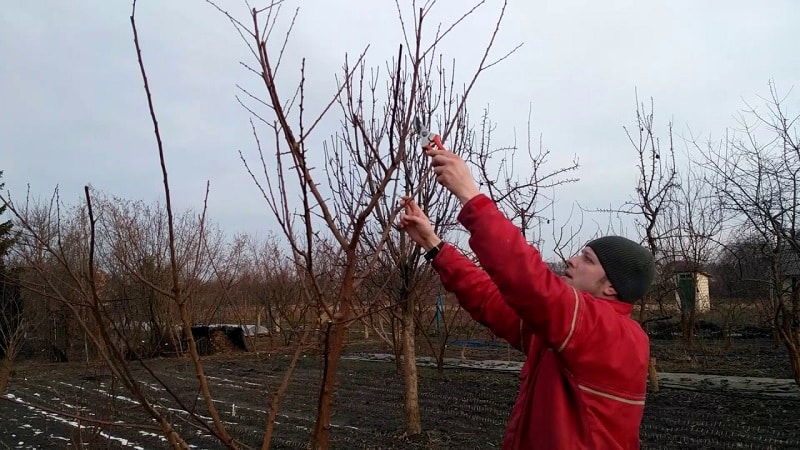
Advantages and disadvantages of carrying out procedures in the spring
The main benefits of pruning in spring:
- stimulation of early fruit ripening;
- increasing the frost resistance of the tree;
- correct crown development.
The only drawback of this procedure is that When it is carried out, the plant begins to awaken early and bloom. If you do not manage to complete all stages of care on time, there will not be a good harvest.
What happens if you don't trim an apricot?
Plant pruning cannot be ignored.. The crown will grow greatly, fruiting will be early, but after 3-4 years the condition of the tree and the quality of the harvest will deteriorate.The branches will grow long and thin, they will begin to break under the weight of the fruits, they will become smaller and lose their taste.
When to prune in spring
The manipulation is carried out during the period of least activity of the tree, until sap flow begins.. To do this, a stable positive air temperature must be established.
Important! Removing too many branches will kill the tree, so pruning should be done sparingly.
In the southern regions, the procedure is carried out at the first warming (in the first ten days of March), in regions where the climate is unstable - in early April, in the northern regions - no earlier than the second half of the month.
Favorable days
Plants are affected by lunar cycles, therefore, many people adhere to the recommendations of the lunar calendar in gardening work. Apricots are pruned during the period of the waning moon, in its third and fourth phases.
Favorable days for pruning in March: 3, 4, 11, 18, 19, 22, 23, 28, 29. In April: 1, 4, 5, 14, 15.
Types of pruning
Apricots are pruned in different ways depending on their age.. There are formative, rejuvenating and regulating pruning.

Formative
The procedure is carried out to form a powerful and well-lit crown, stimulation of branch growth. They form mainly young trees before they enter the fruiting period. For plants that are more than 5 years old, this procedure is not carried out.
Rejuvenating
This method applies to old trees, in which the growth rate of shoots is decreasing in order to extend their fruiting period.
Regulatory
This type of pruning is used for mature fruit-bearing trees.. It is carried out to maintain an optimal ratio of fruiting branches and deciduous branches.Trees are thinned out by removing 1-2 large branches in the middle of the crown, lower side shoots and shoots on the trunk.
To clean trees from dry, frozen and diseased branches, sanitary pruning is carried out in the spring.
How to trim an apricot
For novice gardeners, pruning looks complicated, but if you know the rules and procedure, it is easy to cope with.
Required materials and tools
You will need special tools to trim apricots.. In order not to harm the tree, they must be well sharpened and disinfected with a 1% solution of copper sulfate to prevent the spread of disease.
Required Tools:
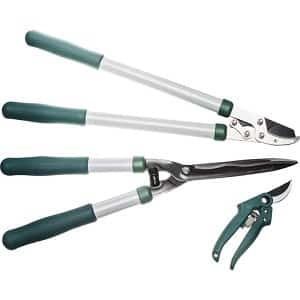 pruning shears for removing small shoots;
pruning shears for removing small shoots;- lopper for trimming high branches;
- garden saw for cutting powerful branches;
- file for cleaning cut areas;
- sharpening tool.
A special paste is also used to disinfect sections. (“RanNet”, “Farmayod”, “Zhivitsu”) and garden varnish to close them.
Step-by-step instructions and cutting diagrams
Different pruning methods are used for trees of different ages.
Pruning young trees
The foundation for the tree crown is laid when planting seedlings. The ground part is shortened to a maximum of 80 cm in height. If the seedling has shoots, they are shortened by 1/3 of the length. During the first 4 years, the crown continues to form.
Sparsely tiered crown shape
In the 1st year, the trunk of the seedling is cut to 1/4 of the length, leaving 2 skeletal branches on opposite sides. There should be 2-3 shoots on the branches.
Next year these 2 main branches are shortened. The crown should have 5-6 skeletal branches 50–60 cm long. By the 3rd year, the length of the skeletal branches is cut to 30 cm.
Note! Semi-skeletal processes in such a crown should be located at intervals of up to 50 cm.Weak side shoots are pinched until they become stronger.
Bowl shape
In the 1st year, plants in one tier select 5 main branches, growing in different directions. All other shoots are removed.
At 2, 3 and 4 years, these branches are shortened to 40–50 cm from the main trunk. Young shoots on the trunk are removed to form a rosette branch.
Reference! Each tier is formed shorter than the previous one.
When the crown takes the shape of a bowl, the central trunk is cut off.
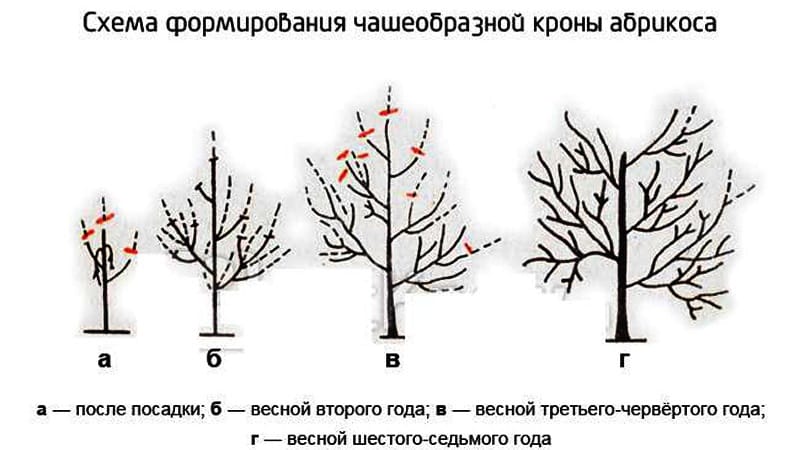
Leader form
This is an arbitrary crown shape. The branches are formed evenly along the length of the entire trunk at equal distances.
In the 5th year of life, the plants cut off the central trunk. This tree has a medium height and a sparse crown, which makes harvesting easier. Young shoots are cut off at least 0.5 cm from the buds.
Pruning mature trees
Mature trees have their yield regulated. To do this, ensure the growth of young shoots. First, shorten 1-2 side branches. In highly branching trees, knots are left 5 cm long, in weakly branching trees - 15 cm.
The next year, cut off the strongest shoot to 10 cm. Other shoots are shortened by 1/3 of the length. Over the course of a season, fruit branches with flower buds form on them, and new shoots form on the twigs.
The following year, the fruit branches are harvested. After harvesting, they are cut back to the lowest branch.
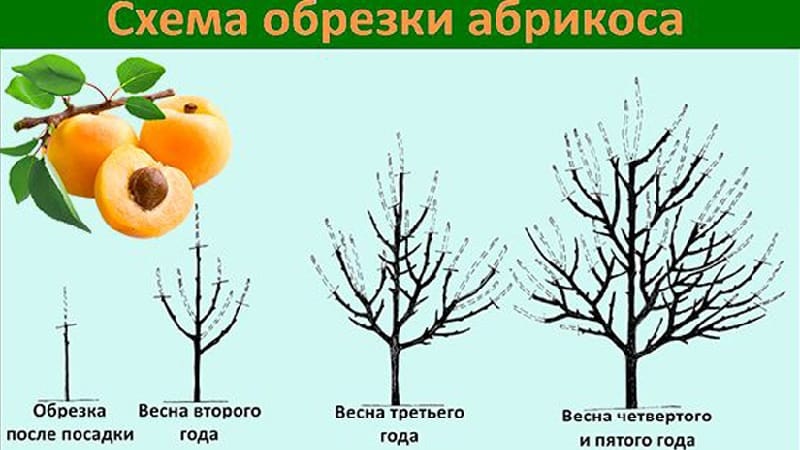
Pruning old trees
Old trees are extended their ability to bear fruit by rejuvenating pruning. The procedure is carried out once every 10 years.
Secondary shoots on the skeletal branches are cut off, after which new ones begin to form. Among them, fruitful branches are selected, and all others are removed.
During the period of growth of young shoots, excess growth is thinned out. Remove 2-3 skeletal branches at a distance of 30–40 cm from the main trunk. When shoots form on them, the most powerful branch is left, the rest are removed.
Interesting things on the site:
Features of the procedure in different growing regions
Abundance of apricot varieties allows you to grow them in different regions. Special climatic conditions require their own approach to growing and pruning.
It is easier to cultivate apricots in the southern regions, Crimea, Kuban, and Ukraine.
In the middle lane and Siberia, where the climate is more severe and the requirements for crop care are stricter. The main difference between regions is the timing of pruning. The warmer the climate, the earlier the pruning is carried out.
In the southern regions, spring pruning is supplemented with summer pruning. The procedure is carried out in the third decade of June. A prerequisite for summer pruning is abundant watering.
Many gardeners in Siberia and other regions where harsh winters prevail recommend not carrying out the procedure in the fall to prevent freezing. For the same purpose, branches are not cut down to the base.
Nuances for columnar apricot
Columnar apricot is called for its appearance.: the tree has practically no side branches, and the fruits are located along the entire length of the main trunk. The fruits themselves are fragrant and large.
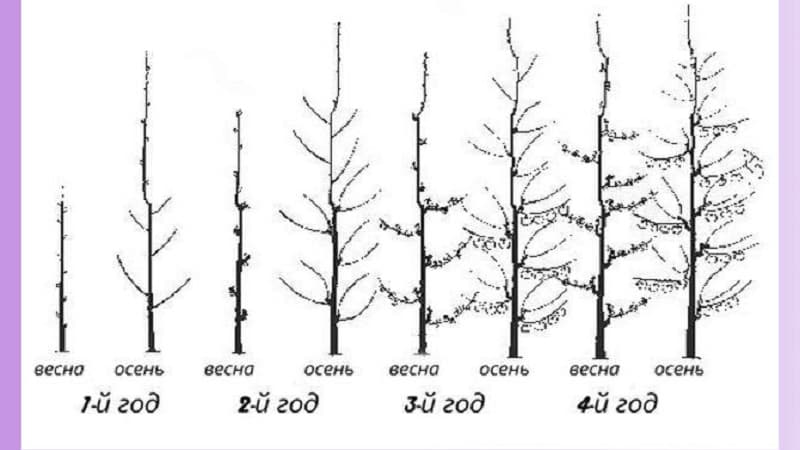
To trim a columnar apricot, the main shoot is shortened to 90 cm. Leave 2-3 branches directed upward. Half of them are cut off. Side shoots are shortened annually to 20 cm, leaving at least 3 buds on each.
Dried branches and without ovaries are removed.The plant is pruned in the fall, in October, and in the spring, at the end of March.
Care after pruning
After the procedure, trees require special care:
- The cut areas must be covered with garden varnish. If the cut surfaces are large, they are disinfected with a solution of copper sulfate.
- Monitor the soil moisture, preventing it from drying out.
- To ensure access of oxygen to the roots, the tree trunk circle is loosened.
- To restore and adapt trees, nitrogen fertilizers are applied under the trunk.
Conclusion
Spring pruning of apricot trees is a mandatory procedure. It is carried out to increase productivity and improve the health of the tree. Different pruning methods are used for plants of different ages, taking into account the climatic conditions of the region. If the procedure is carried out in a timely manner and according to all the rules, the tree will bear fruit abundantly and the quality of the fruit will improve.